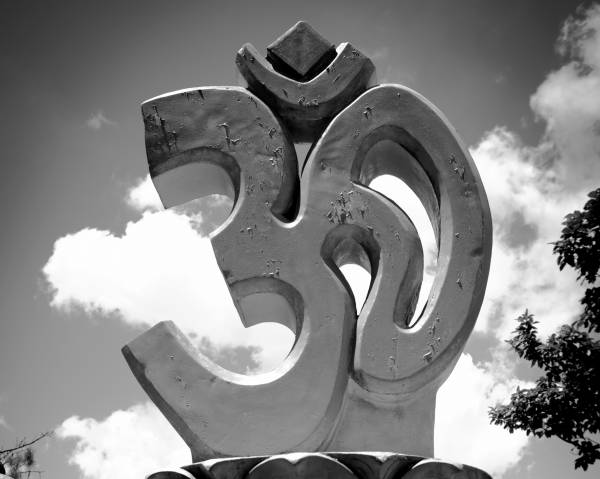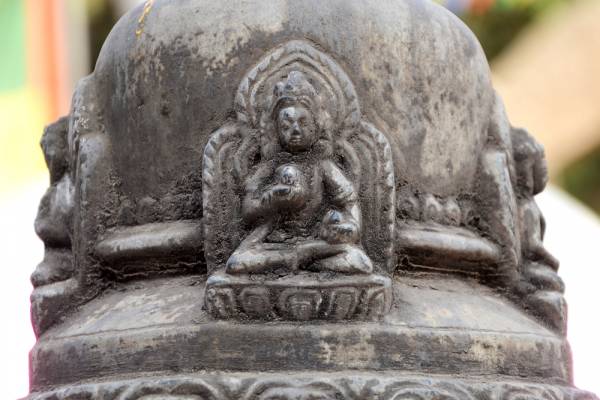To Om, or not to Om – that is the question. You see the Om symbol on bumper stickers, tank tops, tattoos, paintings, and sculptures, but what exactly is it? Is it a Sanskrit symbol to deify and worship? Is it a noun or a verb?
As one of my yoga teacher colleagues put it recently, “Few of the people sporting Om signs on their car, clothes, or body have ever actually chanted om or have any inkling as to its meaning.” The mystery and misunderstanding about “Om” (also written as “Aum”) can present a dilemma for yoga teachers.
Common Misunderstandings About Om
As yoga teachers we work with people of diverse backgrounds and ideologies, and we’re careful not to alienate anyone. But a cross-section of most classes is likely to find the following perceptions lurking in people’s psyches:
- Chanting Om is against my religious beliefs.
- Om-ing is weird, esoteric, or spooky.
- Only strange guys in robes, turbans, or diapers chant.
- I have a terrible voice.
- I’m afraid I’ll make a fool out of myself.
I had all these same resistances when I first explored the world of yoga, but my experience with the way I felt after Om-ing – even just once – melted my resistance. I would and still do feel a physiological shift toward calmness, stability, and equilibrium. As a teacher, when I offer Om to my students, there’s a tangible shift in the room’s collective energy during that silent space after the Om. It is so moving that sometimes I have to hold back tears.
“Om-ing is a foundational aspect of a complete yoga practice, so it’s good to introduce it and give your students the opportunity to Om…”
While there are many ways to explain the magic power of Om, I’m going to touch the surface of a few of them below. Teachers need to be equipped in alleviating their students’ concerns in the same way that insightful instructors over the years have alleviated mine. In this way, teachers can speak to a person’s concerns in a manner that he or she can hear, and more people can receive the benefits of this foundational element of a yoga practice.

The Symbol of Om
That unassuming symbol is full of meaning and purpose. Overall, it signifies the innate capacity within human consciousness to connect with something beyond itself.
The figure that looks like a number three is made up of two curls on top of each other. Then, there is the downward curl that extends to the right from the three-shape. These three shapes signify states of consciousness:
- The top curl represents deep sleep.
- The bottom curl represents the waking state.
- The curl emanating from the side represents the dream state.
These are aspects of the human realm, which every human experiences at one time or another.
“The physiology of mantra, including Om, has to do with the rhythm, tone, phonetics, and reflexology of the tongue on the palate.”
Conversely, the final part of the symbol – the open curve that sits above, with the dot on top – is where we move into the sacred. The dot represents absolute or higher consciousness and the curve that cradles it stands for an infinitely open mind, which is necessary to attain higher consciousness.
Overall, Om signifies the mental connection between the human and the divine through mind or consciousness. (Fun factoid: you can write the symbol from your keyboard by typing backslash in the Wingdings font.)
The Origin
That Self is
the eternal vibration Aum,
which manifests the
grace of the
divine presence.
–Yoga Sutras of Patanjali, Book I, Verse 27
The shortest and most popular chant in the west, Om is the sacred symbol for Hinduism, Buddhism, Jainism, Sikhism, and Zoroastrianism. It’s hard to imagine a word so frequently used today was at one time forbidden in public because of its sacredness. It was mentioned openly for the first time in Vedic scripture. But in the early Vedic period, the word Om wasn’t verbalized in public or written. It was passed on secretly from teacher to student.
“Quantum physics meets ancient wisdom in confirming that at a subatomic level everything is in motion, even if it doesn’t appear that way to our eyes.”

Early Hindu scripture made reference to the sound without using the word. It was referred to as udgita (upsound) or pranava (calling out), among other things. Over time, the word was used more openly and evolved from Om to Aum. The best explanation for this can be found in the Mandukya Upanishad where Aum is described as the sound of Brahman, which is the unchanging reality or the universal Self.
The Sound
By constantly repeating
that sacred sound
with great respect and love
and reflecting upon its meaning,
one attains spiritual wealth.
–Yoga Sutras of Patanjali, Book I, Verse 27
Sound is vibration. Vibration is movement. Quantum physics meets ancient wisdom in confirming that at a subatomic level everything is in motion, even if it doesn’t appear that way to our eyes. If everything is in motion, then everything has a vibration, and thus, a sound. This is easy to forget since not all sounds are audible to the human ear.
Sound has a prominent place in biblical as well as Vedic scripture. In Christianity and Judaism, everything begins with the Word. The Creator speaks creation into being. That same creative force or vibration is represented in Hinduism as the sacred sound Om or Aum.
The physiology of mantra, including Om, has to do with the rhythm, tone, phonetics, and reflexology of the tongue on the palate. The sound Aum in traditional Sanskrit, is composed of four parts – three audible sounds and the unheard sound (silence) at the beginning and the end:
- The A sound (pronounced “ah” like father) resonates in the throat and is known as the primal sound. It is said to include all sounds produced by the human vocal chords and represents normal waking consciousness.
- The U (pronounced like “who”) vibrates in the back of the mouth. U symbolizes dream consciousness where things are more fluid and both subject and object are within us.
- The vibration reaches the lips with M, the final humming sound, which represents deep sleep. This sound resonates in the front of the mouth and buzzes throughout the head.
- The final sound is the silence after the M. This is where stillness, clarity, and inner peace are experienced. You can see these sounds correspond to the meaning of the symbol.
The Practice
From that practice
arises the attainment of
inward-directed consciousness,
and also
the obstacles
to success
disappear.
–Yoga Sutras of Patanjali, Book I, Verse 27

An Invitation to Om
The three verses from the Yoga Sutras that I’ve woven through this piece end with the promise above. One way I invite my students to Om/Aum is by sharing these verses with them. I figure what better way than right from the horse’s mouth, so to speak. And after all, who doesn’t want success? Om-ing is a foundational aspect of a complete yoga practice, so it’s good to introduce it and give your students the opportunity to Om or not.
RELATED: How Do I Write a Personal Mantra?
Hopefully this overview will give you a sense of the vast scope you can draw from incorporating the chant into your classes, if you haven’t already. Always keep in mind some of the perceptions (most of them misperceptions) that have a hold on your students and put their minds at ease by speaking to those.
Less important than the facts is the way Om is filtered through your unique understanding and perspective, as well as the results you have from your own experience. When shared from that place, the practice will have relevance and attractiveness for your students.
References:
1. Mukunda Stiles (translation), Yoga Sutras of Patanjali, Weiser Books, November 2001.
2. Swami Krishnananda, The Mandukya Upanishad.
3. Karen L. Hudson. What Is Om (Aum)? About Style.
4. Kundalini Yoga. Mantras, Modified November 2, 2014.
5. Om Healing, Sound of Om (Aum).
6. Jayavaram V. Om, Aum, Pranava, or Nada in Mantra and Yoga Traditions, Updated November 2, 2014.
7. Oming in the Wind. Oming in Yoga. August 2009.
Photos courtesy of Shutterstock.






